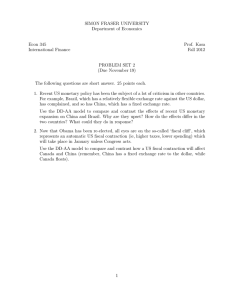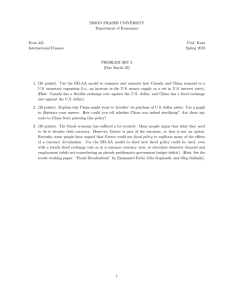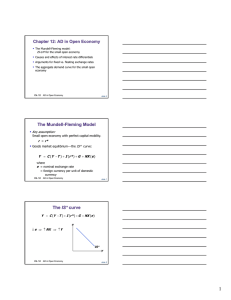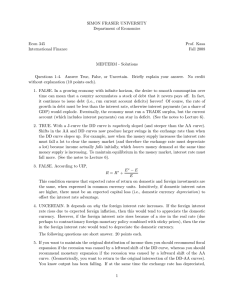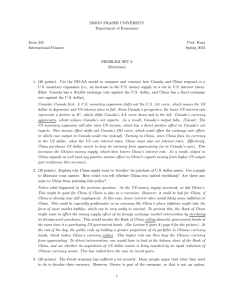SIMON FRASER UNIVERSITY Department of Economics Econ 345 Prof. Kasa
advertisement
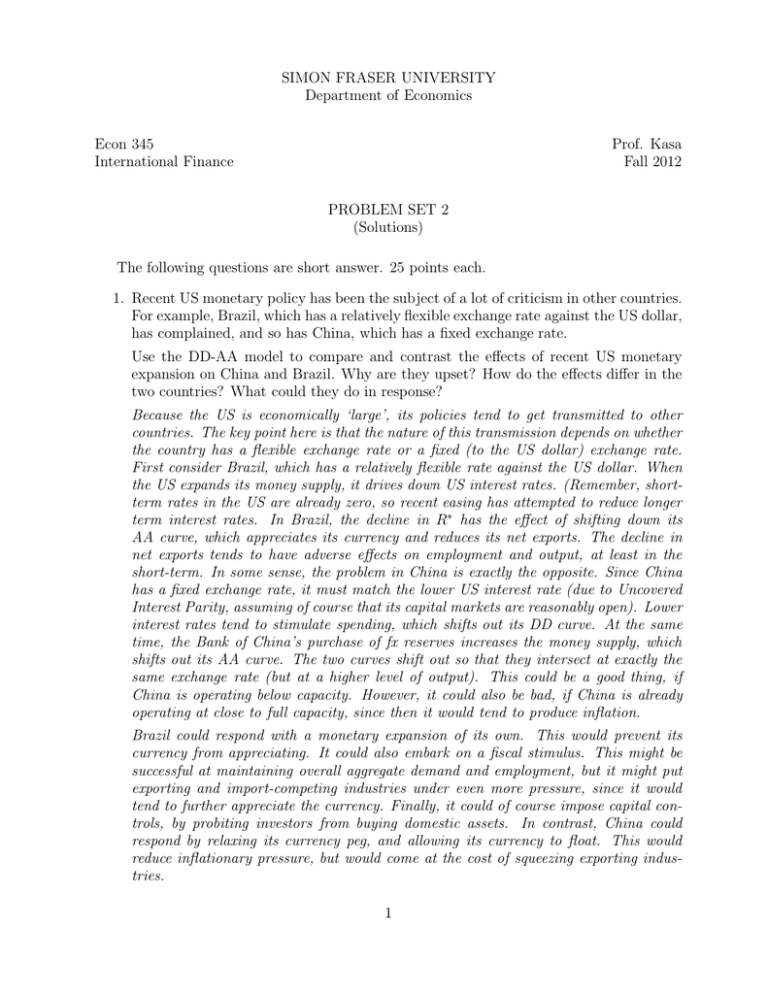
SIMON FRASER UNIVERSITY Department of Economics Econ 345 International Finance Prof. Kasa Fall 2012 PROBLEM SET 2 (Solutions) The following questions are short answer. 25 points each. 1. Recent US monetary policy has been the subject of a lot of criticism in other countries. For example, Brazil, which has a relatively flexible exchange rate against the US dollar, has complained, and so has China, which has a fixed exchange rate. Use the DD-AA model to compare and contrast the effects of recent US monetary expansion on China and Brazil. Why are they upset? How do the effects differ in the two countries? What could they do in response? Because the US is economically ‘large’, its policies tend to get transmitted to other countries. The key point here is that the nature of this transmission depends on whether the country has a flexible exchange rate or a fixed (to the US dollar) exchange rate. First consider Brazil, which has a relatively flexible rate against the US dollar. When the US expands its money supply, it drives down US interest rates. (Remember, shortterm rates in the US are already zero, so recent easing has attempted to reduce longer term interest rates. In Brazil, the decline in R∗ has the effect of shifting down its AA curve, which appreciates its currency and reduces its net exports. The decline in net exports tends to have adverse effects on employment and output, at least in the short-term. In some sense, the problem in China is exactly the opposite. Since China has a fixed exchange rate, it must match the lower US interest rate (due to Uncovered Interest Parity, assuming of course that its capital markets are reasonably open). Lower interest rates tend to stimulate spending, which shifts out its DD curve. At the same time, the Bank of China’s purchase of fx reserves increases the money supply, which shifts out its AA curve. The two curves shift out so that they intersect at exactly the same exchange rate (but at a higher level of output). This could be a good thing, if China is operating below capacity. However, it could also be bad, if China is already operating at close to full capacity, since then it would tend to produce inflation. Brazil could respond with a monetary expansion of its own. This would prevent its currency from appreciating. It could also embark on a fiscal stimulus. This might be successful at maintaining overall aggregate demand and employment, but it might put exporting and import-competing industries under even more pressure, since it would tend to further appreciate the currency. Finally, it could of course impose capital controls, by probiting investors from buying domestic assets. In contrast, China could respond by relaxing its currency peg, and allowing its currency to float. This would reduce inflationary pressure, but would come at the cost of squeezing exporting industries. 1 2. Now that Obama has been re-elected, all eyes are on the so-called ‘fiscal cliff’, which represents an automatic US fiscal contraction (ie, higher taxes, lower spending) which will take place in January unless Congress acts. Use the DD-AA model to compare and contrast how a US fiscal contraction will affect Canada and China (remember, China has a fixed exchange rate to the dollar, while Canada floats). A US fiscal contraction would shift the US DD curve up and to the left. The US exchange rate would depreciate, and its interest rates would fall. The decline in US interest rates would shift Canada’s AA curve to the left, which appreciates its currency and reduces its net exports. At the same time, Canada’s DD curve would also tend to shift left, since the fiscal contraction in the US would likely reduce US output and imports (from Canada). So Canada’s output and employment would likely fall for both reasons. In contrast, lower US interest rates would require a monetary expansion in China. The expansion might be less than in the previous question, since lower US incomes would likely depress China’s exports to the US. Still, at the end of the day, the picture in China would look the same as in the first question. Its DD curve shifts out due to lower interest rates, and its AA curve shifts out due to its purchase of fx reserves. 2
